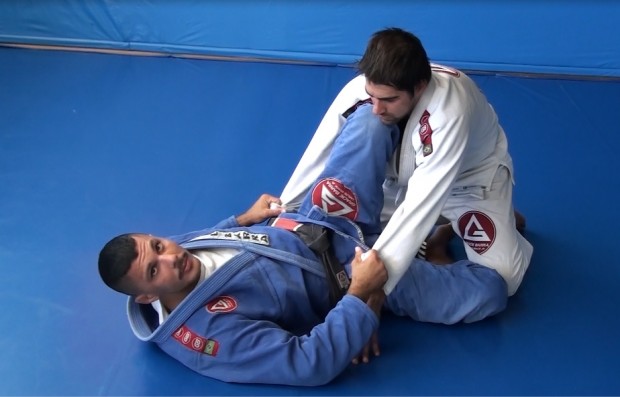Bluebelt – Advice on Developing your Guard
If the focus of the 1st year of training for any new student of Brazilian jiu-jitsu (see related articleThe Evolution of Skill – From Fundamentals to Advanced) is to learn the proper mechanics of the fundamental techniques and recognize technique options from each of the basic ground positions then what is the focus of the bluebelt?
One way of looking at the phase of bluebelt is the bluebelt is the belt of variations. More specifically experimenting with the many variations of the guard position.

Bluebelt is a really fun time in ones study of jiu-jitsu. The bluebelt has enough experience that they are able to not only defend themselves but can dominate positions and work their offensive game.
And more than anything, it is a time to learn and exchange variations of the techniques with their classmates. At open mat sessions it is common to see clusters of bluebelts at the end of the mat demonstrating variations of techniques “I was watching a video at the Mundials, and Braulio Estima sets up his triangle like this!”
I often ask bluebelt students at my Gracie Barra academy: “What is your guard?”
They are not sure how to answer the question.
I list several of the variations of open guard used in modern sports bjj:
leg lasso guard
spider guard
butterfly guard
De la Riva guard
X-guard
reverse De la Riva
cross guard
sitting guard
and so on…..

I express my opinion that bluebelt is the phase where one experiments with the different types of guard.
Here are 4 tips to help you develop your guard:
1) Give it at least a month:
I challenge the student to start to focus on using a certain type of guard for the next month or 2 during their rolls. You have to give it enough time to see if it is a good fit for you, that is why I say a month. Your earliest attempts using any new technique against fully resisting opponents will not be very successful.
You need to go through that awkward initial phase where your success is low but you are getting comfortable in the position without getting discouraged and giving up. A month will give you a fair chance to see if this guard type is going to be a good style for your game.
2) Spend lots of time in the position:
There are no shortcuts to developing a technique or position. My head instructor at Gracie Barra Calgary, Prof. Josh Russell says succinctly “You have to spend a lot of time in that position in training.”
Go on a Butterfly Guard Mania for the next month!
Ask your training partners if you can start in that guard position to provide yourself a chance every roll to try out your guard.
After every tap, restart in your butterfly.
Against advanced belts, ask if you can start the match in their butterfly guard, so you can feel their control and see how they deal with your attempts to pass.
At any time on the bottom during the roll, instead of going to the guard you habitually use, force yourself to go to the butterfly guard.

3) Pick a guard that suits your physical type:
By the time one attains blue belt one is able to observe that ones body type and physical attributes plays a significant role in how you roll.
It is difficult to become a triangle specialist with short, thick legs compared to longer legged training partners who slap on triangles effortlessly.
Marcelo Garcia is famous for his butterfly guard which is a great fit for his build and has developed an entire guard game around the butterfly and its related guards like X-guard.
Romulo Barral has a more rangy build and is famous for his spider guard and dangerous attacks built around those grips.
4) Study the masters:
Ideally, your own instructor has the guard you are experimenting with – as a strength in their own game. Bring your specific questions about that guard to them at a convenient time at the end of class to get some tips for you to try.
There is very likely an advanced belt ion your academy that has a well developed butterfly guard. They will have many variations and have the details for the grips and counters. Tell them you are working on your own butterfly guard and pick their brains. One of the best things about bjj is the willingness for practitioners to share their knowledge with less experienced students.
Youtube can be an incredible resource for those wanting to study a specific technique!
Tutorials galore on any type guard from multiple time world champions. Complete DVD sets on a single aspect of the guard.
Watch the competition footage of elite level BJJ players to study how they counter their opponents passes; which submissions or sweeps are effective from that specific guard.
Share in the comments: “What is your guard?”
Credits: Mark Mullen
GB Black belt from GB Calgary, Canada
Twitter: @MarkMullenBJJ
